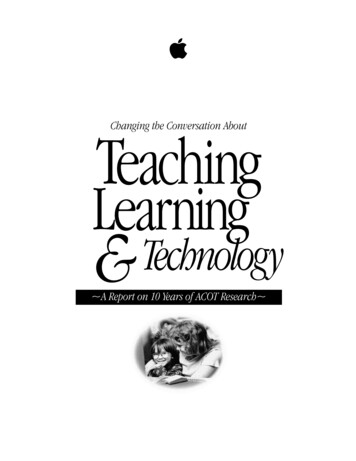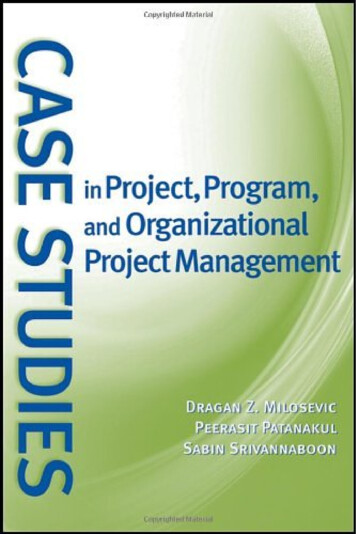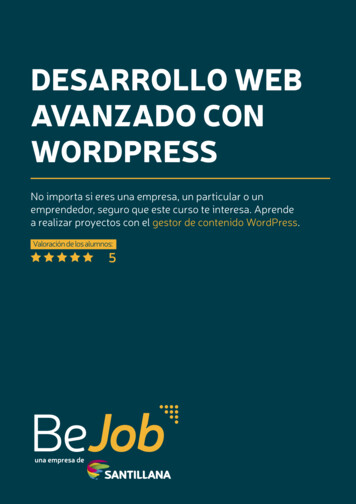
Transcription
Changing the Conversation AboutTeachingLearningTechnology& A Report on 10 Years of ACOT Research
“What happens when computers become a significant resource in classrooms? How does acritical mass of technology affect the way teachers teach and learners learn?” These werethe questions that were raised when the ACOT project began. For more than a decade,researchers, practitioners, and technology developers have been able to work together toincrease our understanding of what can happen in classrooms when powerful technologyand effective instruction are joined. The lessons learned provide a rich foundation of experience and knowledge to guide current investments in technology at the local, state, andnational level.—Linda G. Roberts, Director, Office of Educational Technology,U.S. Department of EducationBecause of ACOT and the technology, Icontinue to be enthusiastic about being ateacher. But I am an altogether differentteacher than I was before. I am now guidingthe students. They are the masters of theirown education now, creating their ownknowledge and using their creativity toresearch and explain information to others.—Chris Stortz, ACOT Teacher,Stevens Creek Elementary School, Cupertino, CaliforniaA Report on 10 Years of ACOT Research2
What we observed was the realitythat multimedia and multiple layersof information helped students morethoroughly and more dynamicallyexplore ideas.—Robert J. Tierney, Professor and Chair,Educational Theory and Practice,The Ohio State UniversityUsing technology as a motivator for change and a tool for teaching and learning,today’s ACOT Teacher Development Centers engage teachers in the same kindsof challenging and collaborative learning activities that they aim to provide theirstudents. As such, these centers are an evolving solution to the most pressingdilemma facing education reform: how to spread the accomplished practice froma few teachers and schools to many.—Dr. Jane L. David,Director, Bay Area Research Group, Palo Alto, CaliforniaA Report on 10 Years of ACOT Research3
198519861987Initiating ACOTEducators at Apple initiated aresearch project to answer thequestion: What happens to students and teachers when theyhave access to computers whenever they need it? This meant thatthe technology was always available—not down the hall in a lab,and not left behind when students went home after school.First sites selected—one classroom each in Eugene, Oregon,and Blue Earth, Minnesota.ACOT supplied the computersand trained the teachers. Ourdistrict partners paid for staffing,physical modifications to theclassrooms, and extra insurance.Additional sites were addedin Columbus, Ohio; Cupertino,California; Houston, Texas;and Memphis and Nashville,Tennessee.First public presentations aboutACOT—at MECC and AppleFest.The ACOT Senior ScholarsConference, attended by a groupof distinguished researchers,developed a research agendafor ACOT.The sites at Houston and Eugenewere closed in favor of addingmore classrooms at the othersites.The ACOT Teacher SummerConference gave teachers atthe ACOT sites an opportunityto meet, share experiences,and learn more about teachingwith technology.1986–87: The start of longitudinal research*We knew that changes in teachers—and in schools—happen over time. During the first two years,we simply observed what was happening in the classrooms. ACOT teachers used word processing and electronic mail to send weekly reports from each siteto ACOT staff at Apple. And each teacher sent monthly audiotape journals to the researchers inwhich they expressed their personal frustrations as well as their victories. ACOT researchers developed a database to store the information—without losing any of thedescriptive quality—and began looking at major themes. Eva Baker (UCLA Center for Technology Assessment) began examining the impact of the ACOTprogram on students, staff, and parents. Robert Tierney (The Ohio State University) began a longitudinal study of the thought processesof ninth-graders at the ACOT high school site—exploring the potential of technology as a tool tostrengthen and expand students’ thinking skills. Elfrieda Hiebert (University of Colorado) collaborated with an ACOT third-grade teacher todescribe and assess a computer-intensive writing curriculum.*ACOT research reports are available on many of these topics. See “Where to get more information”at the end of this report.A Report on 10 Years of ACOT Research4
1988198919901991We continued to add classroomsat the sites.ACOT research studies werepresented at the AmericanEducation Research Association(AERA), the InternationalReading Association (IRA), andthe International Association ofComputing Educators (IACE).ACOT was featured in a reporton the use of technology inAmerican schools published bythe U.S. Office of TechnologyAssessment.We focused on three sites—Columbus, Cupertino, andNashville—so we could learnmore by working intensivelywith fewer schools. We also continued to add classrooms so wecould follow students throughmore grades.We published reports onHiebert’s writing research, onthe first two years of Tierney’slongitudinal study of students’thinking, and on Fisher’s studyof student empowerment.We began preliminary work ona teacher development modelat the Nashville site.1990–95: Amplifying our voiceRealizing that more people needed to hear what we’d learned about teaching and learning with technology—especially about the need for new forms of assessment and new approaches to staff development—we increasedour speaking engagements beyond the community of educational researchers. We also began responding torequests for information from state and national policymakers.We published reports on Baker’stwo-year evaluation study andConfrey’s development of FunctionProbe and a problem-based mathematics curriculum. We also published our four-year study of theevolution of teachers’ beliefs andpractices and our study of classroom management—both by Dwyer,Ringstaff, and Sandholtz. And wemade presentations on severalresearch projects at AERA.1990– 93: Developing integrated environmentsVisitors from South America andthe USSR toured ACOT sites.ACOT was cited in articles inUSA Today, The New YorkTimes, Business Week, BostonGlobe, and the Japanese counterpart of PC Magazine, andfeatured on NBC Nightly News.1988–89:Continuation of longitudinal researchWe introduced multimedia at the sites and continued our observations, finding themes thatwe wanted to address more fully. Recognizing that teachers’ practice was becoming more learner centered, we began focusing our staff development sessions to encourage a constructivist approach to teaching. We started an investigation of the interrelationships among learning, computers,and space. We realized the limitations of traditional assessment measures for capturing the changeswe saw in the ACOT students. We also discovered that the students were developing a variety of new competencies notusually measured. We began developing a common language to help teachers collaborate more effectively.1988–89: Expansion of research collaborationWe began funding the work of researchers at other institutions whose projects addressedissues and themes we had found in the observational research. In alternative assessment, we began working with Allan Collins (Northwestern University)and Jan Hawkins (Center for Children and Technology) and continued our relationshipswith Tierney and Baker. In writing, we began collaborating on a language arts assessment tool with MidianKurland (Educational Development Center) as well as on telecommunications-basedwriting workshops for teachers. In task design, we began working with Charles Fisher (University of Colorado) on creatingprojects that empowered students and on the associated needs for staff development. In staff development, we worked with Jean Marsh ( Vanderbilt University) on a new staffdevelopment model for ACOT teachers.A Report on 10 Years of ACOT ResearchRealizing that technology—and especially wireless technology—could havean especially strong impact in the areas of collaboration, communication,and the construction and expression of knowledge, we used the results ofour research to create specific learning environments that demonstratedthe integration of these areas. Then we produced short videos to documentthe projects. The project known as “Wireless Coyote” explored the use of mobile, networked, and multirepresetational technology—as well as the effects ofa constructivist environment—during a science field trip for middleschool students. The project known as “Cloud Forest Classroom” replicated WirelessCoyote in another location and with other students. For this study, wedeveloped and tested an integrated data collection, data analysis, andmessaging environment to support collaborative field activities. The project known as MediaFusion involved an integrated environmentthat allows developers to make conventional TV broadcasts explorableby computer. It gave teachers, students, researchers, and our partners atthe Public Broadcasting System (PBS) a view of how interactive TV mightsomeday be used for learning. Presentations to the U.S.Department of Education,President’s National EducationGoals Committee, NationalGovernors Association,Education Commission of theStates, National Center forEducation and the Economy,Fortune 500 MagazineEducation Summit, FederalCommunications Commission,and Smithsonian Computerworld program Presentations at regional andnational conferences includingthe American EducationResearch Association, AmericanPsychological Association,National Education ComputingConference, Computer-UsingEducators, InternationalReading Association, AmericanAssociation of Physics Teachers,American Math Society, NationalScience Teachers Association,and the Cognitive Science Society Article in EducationalLeadership on changes inteachers’ beliefs and practices1989–92: Encouraging new uses of technologyTechnological advances now allowed developers to create tools that represented ideas in multiple formats—text, images,video, graphics, tables, and charts. We began collaborating with researchers who were developing multirepresentationaltools that could aid in knowledge construction. The product list included Function Probe, Science for Living, GeometryTutor, Physics Tutor, Digital Image Processing, and TableTop.We also began working with researchers at the Ontario Institute for Studies in Education on CSILE, a computer-supportedcollaborative learning environment for children.1990–95: Developing additional partnerships With the National Science Foundation, we established ACOT Teacher Development Centers at three sites in order toinvestigate more fully the effectiveness of this new approach to professional development. With the National Alliance for Restructuring Education, we created a network of Teacher Development Centers inparticipating schools. This allows us to work in environments in which restructuring is already under way and alsoto see how the staff development model can be replicated on a larger scale. With the San Francisco Exploratorium and a local school district, we are investigating how elementary school teacherscan use a multimedia messaging system and a media-rich environment to enhance communication, collaboration,and inquiry.5
19921993199419951990–95: Amplifying our voiceRealizing that more people needed to hear what we’d learned about teaching and learning with technology—especially about the need for new forms of assessment and new approaches to staff development—weincreased our speaking engagements beyond the community of educational researchers. We also began responding to requests for information from state and national policymakers. Presentations at meetings of theAmerican Education ResearchAssociation, AmericanPsychological Association, andthe California BusinessRoundtable Presentations to the commissioners of education and theirstaffs for Kentucky, Vermont,New York, Indiana, and Ohio Presentations to 11 SovietRepublic Ministers of EducationWe published a report on fiveyears of Tierney’s longitudinalstudy of the influence of high computer access on students’ thinking,learning, and interactions. Wealso published reports by Ringstaff,Sandholtz, and Dwyer on therelationship between technological innovation and collegialinteraction and on the classroomresults of teachers using students’technology expertise. We publisheda report on the school-universitybusiness partnerships that makeup ACOT, as well as a report ona second-grade multimedia-composing project. Presentations to several stateboards of education andlegislators Briefings to educators andpolicy makers from the UnitedKingdom, Singapore, Japan,Bulgaria, Saudi Arabia,Turkey, Portugal, Poland,United Arab Emirates,Hungary, and France More than 25 national andregional newspapers,magazines, and TV stations—including the Wall StreetJournal, The New York Times,Forbes Magazine, andEducation Week—cited ACOTas a reference.1990– 93: Developing integrated environmentsRealizing that technology—and especially wireless technology—could have an especiallystrong impact in the areas of collaboration, communication, and the construction andexpression of knowledge, we used the results of our research to create specific learningenvironments that demonstrated the integration of these areas. Then we produced shortvideos to document the projects. The project known as “Wireless Coyote” explored the use of mobile, net-worked, and multirepresetational technology—as well as the effects of a constructivist environment—duringa science field trip for middle school students. The project known as “Cloud Forest Classroom” replicated Wireless Coyote in anotherlocation and with other students. For this study, we developed and tested an integrateddata collection, data analysis, and messaging environment to support collaborativefield activities. The project known as MediaFusion involved an integrated environment that allowsdevelopers to make conventional TV broadcasts explorable by computer. It gave teachers,students, researchers, and our partners at the Public Broadcasting System (PBS) a view ofhow interactive TV might someday be used for learning. Presentations to the U.S. Office ofTechnology Assessment and theCouncil of Great City Schools Presentations to a variety ofeducational reform groups,including the New AmericaSchools governing board,National Alliance for Restructuring Education, ATLASproject, and the Coalition forEssential Schools Presentations to ministries ofeducation for New Zealand,Singapore, and the EuropeanCommission Article in EducationalLeadership on lessons fromACOT classrooms Distribution of ACOT researchsummaries to 40,000 educators Presentations to ministriesof education in Denmark,Sweden, India, Bolivia,Scotland, Great Britain, Chile,Australia, and New Zealand Meetings with the commissioner for education of theEuropean Union Participation in a PBS serieson educationWe published Stuebing’s report onphysical environments for learningwith technology; Ringstaff, Wilmore,and Yocam’s reports on the pilotprogram and first year of the ACOTTeacher Development Centers project; Sandholtz and Ringstaff ’sreport on student engagement;and a report on the MediaFusionproject. We made presentationson ACOT-related research atconferences in London, Boston,St. Petersburg, and San Francisco.1990–95: Developing additional partnerships With the National Science Foundation, we established ACOT Teacher Development Centers at three sites in order to investigate more fully the effectiveness of this new approach to professional development. With the National Alliance for Restructuring Education, we created a network of Teacher Development Centers in participating schools. This allows us to work in environments in which restructuring isalready under way and also to see how the staff development model can be replicated on a larger scale. With the San Francisco Exploratorium and a local school district, we are investigating how elementary school teachers can use a multimedia messaging system and a media-rich environment to enhancecommunication, collaboration, and inquiry.A Report on 10 Years of ACOT Research6
1996Initiating ACOT 2000At the beginning of ACOT’ssecond decade, we’re bothexpanding our current workinto new arenas and continuingto ask new questions aboutteaching and learning withtechnology. What happens when studentshave a learning environmentin which technology resourcesare available wherever they’reneeded—unlike most classrooms, which use desks anddesktop computers? What are the effects of bringinghighly innovative math andscience curricula into studentcentered, constructivist ACOTclassrooms? Can we apply the ACOT principles to a global study of the useof technology for learning?For the past 10 years, Apple has sponsored a research project calledApple Classrooms of Tomorrow (ACOT) that is investigating the relationshipbetween technology and education. The ACOT experience has been uniquefor us. The research is exploratory and open-ended. And, over the years,it has brought us into partnership with students, educators, and researchersthroughout the nation.We’d like to use what we’ve learned in ACOT to change the conversationabout technology and education. Instead of talking about computers, forexample, we talk about learning. We describe what happens when studentsuse technology as a tool for building their own knowledge—and examine theimpact on the kinds of skills they develop. We discuss how teachers can usetechnology to create more challenging learning environments—and suggesta staff development process that can facilitate that. And we explore ways todeepen our understanding of how technology can be used as a tool forlearning.This is a work in progress. The following report presents some of theACOT findings and suggests the implications they have for education. Butthere’s always more to be learned.David C. Dwyer, Ph.D.Distinguished ScientistApple Classrooms of TomorrowA Report on 10 Years of ACOT Research7
It all startedwith a question:A Report on 10 Years of ACOT Research8
During the mid-1980s, a time of great excitement about using technologyto enhance education, educators at Apple proposed a simple experiment.They would create environments in which technology was used asroutinely as paper and books—and then observe the effects on teachingand learning.WHATHAPPENSWorking with partner districts, they selected schools and classrooms, and they gave two computers to each student and teacher—oneTO STUDENTSfor school and one for home. (In those days of bulky equipment, thisAND TEACHERSwas the only way to provide immediate and routine access.)WHEN THEYHAVE ACCESSFrom the outset, the investigation team was composed of university-based researchers, ACOT staff members, and teachers—who played animportant role in describing classroom changes. With electronic mail andTO TECHNOLOGYaudiotape for communication, and encouragement to reflect on theirWHENEVER THEYNEED IT?experiences, the teachers flooded the ACOT staff at Apple with theirobservations. As the volume of communication grew, the ACOT researchers developed a database for the anecdotal data and began investigatingthemes relating to technology and change. Research-ers from otherinstitutions also began to conduct investigations in the ACOT settings.A Report on 10 Years of ACOT Research9
By the end of the first year, students’ behavior and attendance improved, alongwith their attitude toward themselves and toward learning. Performance also“The students don’tget tired of workingon the computer. Theyimproved in several ways: Test scores indicated that, despite time spent learningto use the technology, students were performing well—and some were clearly performing better. The students wrote more, more effectively, and withgreater fluidity.actually ask for thingsto do. In all of my Some classes finished whole units of study far morequickly than in past years.years of teaching, Inever had anyone askfor another ditto.”–Robert Howell,Fourth-grade Teacher,Dodson Elementary School,Nashville, TennesseeDispelling widespread myths, the researchers found that instead ofisolating students, access to technology actually encouraged them tocollaborate more than in traditional classrooms. And instead of becomingboring with use, technology was even more interesting to students as theybegan using it for creating and communicating.Over time, independent researchers found that students in ACOTclassrooms not only continued to perform well on standardized tests butwere also developing a variety of competencies not usually measured. ACOTWhathappens tostudents did the following:students.A Report on 10 Years of ACOT Research Explored and represented information dynamicallyand in many forms. Became socially aware and more confident. Communicated effectively about complex processes. Used technology routinely and appropriately. Became independent learners and self-starters. Knew their areas of expertise and shared thatexpertise spontaneously. Worked well collaboratively. Developed a positive orientation to the future.10
.and teachers?These findings suggested the need for more research, both inACOT has revitalizedthe teaching processtremendously. It hasalso been the catalystthe area of assessment and in ways to develop similar environments forfor a transition fromlearning in other schools.blackboards and text-As ACOT teachers became comfortable with the technology, theybooks to a methodreported they were enjoying their work more and feeling more success-of instruction whereful with their students. Over time, they also reported that they interactedstudents can explore,differently with their students—more as guides or mentors and less likediscover, and constructlecturers. In fact, their personal efforts to make technology an integraltheir own knowledge.part of their classrooms caused them to rethink their most basic beliefs—Barry Stebbins, Science Teacher,West High School, Columbus, Ohioabout education and opened them to the possibilities of redefininghow they went about providing opportunitiesfor students to learn. This suggestedthe need to explore professionaldevelopment issues.A Report on 10 Years of ACOT Research11
Understanding the roleof technologyNot surprisingly, teachers and researchers found that an array of toolsfor acquiring information and for thinking and communicating allowsmore children more ways to become successful learners. But theyalso found that the technology itself is a catalyst for change—encouragingfundamentally different forms of interactions among students and betweenstudents and teachers, engaging students systematically in higher-ordercognitive tasks, and prompting teachers to question old assumptionsabout instruction and learning.A Report on 10 Years of ACOT Research12
The ACOT classrooms have become a model for interdisciplinarystudies, team teaching, and addressing individual learning styles.These are all concepts that have been around for many years, butthat are not easily put into practice. Introducing technology intothe classroom provides a catalyst to actually put these conceptsinto practice and helps both students and teachers to succeedin dramatic ways.—Jane Pratt, Supervisor,Department of Instructional Technology,Columbus Public Schools, Columbus, OhioThe chart below shows the shift that occurred in classroomsas the ACOT teachers extended their traditional views of teaching andlearning—from instruction to knowledge construction.A Report on 10 Years of ACOT ResearchTraditional (instruction)Extended (knowledge construction)ActivityTeacher-centered and didacticLearner-centered and interactiveTeacher roleFact teller and expertCollaborator and sometimes learnerStudent roleListener and learnerCollaborator and sometimes expertLearning emphasisFacts and replicationRelationships and inquiryConcept of knowledgeAccumulationTransformationDemonstration of successQuantityQualityAssessmentNorm-referenced andmultiple guessCriterion-referenced andperformance portfoliosTechnology useSeat workCommunication, collaboration,information access, and expression13
What’s important to knowfor today’s schools?Early on, we found that with powerful, multipurpose tools and a learningenvironment that balances the appropriate use of direct instruction witha collaborative, inquiry-driven, knowledge-construction approach, studentscan achieve far beyond today’s expectations. We also discovered that teachersare the key to creating such learning environments. And we found that theyneed broad administrative support both to create these environments andto sustain them.Although few schools offer the degree of technology access found inACOT classrooms, our research raises some important points for today’sdiscussions about education. These ideas, though powerful, are also so simple that we sometimes refer to them as “the cutting edge of common sense.”Learning needsto be meaningful.We need to balance curriculum-basedinstruction with opportunities for studentsto use an inquiry-based, collaborativeapproach to solve meaningful problems.Problem-based learning lets students buildon their own knowledge and incorporatenew information with what they havealready learned. And when technology isavailable to students, it not only opens upopportunities to solve problems, it alsoprovides additional tools for communication and collaboration.Examples abound of ACOT studentsbeing engaged in meaningful learningactivities. For instance, fourth-graderscapped a semester of technology-enrichedproject-based learning by initiating theirown writing project. During the last threeweeks of the school year, they designed,wrote, and produced “how-to” handbooksfor the incoming fourth-graders—to helpthe new students more easily learn how touse ACOT’s technology-based tools.This experience has made me take risks. I’ve decided the worst thatcan happen is I make mistakes and I need to ask others for help. I thinkif I show that I take risks and make mistakes in teaching, my childrenwill feel more comfortable doing the same in learning.—Participant in the ACOTTeacher Development Center programA Report on 10 Years of ACOT Research14
As you work into using the computer in the classroom, you start questioningeverything you have done in the past, and wonder how you can adapt it tothe computer. Then, you start questioning the whole concept of what youoriginally did.— Paula Fistick, Math Teacher, West High School, Columbus, OhioStudents at the ACOT high school site,engaged in an interdisciplinary study oftheir city, constructed a mechanized, 12foot-square, scale model of the downtownarea—and honed their skills in mathematics, language arts, and robotics as well asin critical thinking, problem solving, andresource management. Replicating theproject the following year, the next classadded a level of complexity. After videotaping the entire process, they used thevideo output to create an interactive,computer-driven exhibit for the city’sscience museum.A Report on 10 Years of ACOT ResearchTechnology is acatalyst for change.Bringing technology into the classroomlevels the playing field between teachersand students—creating an unfamiliarchallenge for teachers. This effect is compounded when the students know moreabout the technology than their teachers—or simply learn to use it faster. Althoughteachers may initially be uncomfortable inthat situation, they also discover unexpected benefits. For example, many teachersdevelop more empathy for studentsbecause they, too, are experiencing beinglearners. They also develop new respectfor those students who learn enough tobecome “local experts” in the technologyarea, and often rely on them to helpothers.As teachers become comfortable with ashift in classroom roles, they may startextending their idea of what it means to bea teacher. If they’re supported, they mayalso change their approach to teaching andlearning—from curriculum-centered tolearner-centered, from individual tasks tocollaborative work, and from passivelearning to active learning.15
As a result of my experiences at the center,I am now allowing mychildren to have morecontrol of the equipment. Before, I wouldhave the children typeon the word processor,and I’d save it for them.Then, in the evening, Iwould print their thingsfor them. Now I letthem do it all.—Participant in theACOT TeacherDevelopment CenterprogramA Report on 10 Years of ACOT ResearchTeachers progress through stagesas they learn how to incorporatetechnology in classroomenvironments.We observed that teachers’ approach tothe use of classroom technology evolvesthrough a few orderly stages: entry,adoption, adaptation, appropriation, andinvention. And we found that certain kindsof support help speed that evolution:mentors who are further along in theprocess, opportunities for reflection, andencouragement to question their beliefsabout teaching and learning.A framework for collaborationcan support teachers in thechange process.When teachers have an opportunity tocollaborate with peers, for example indeveloping or assessing classroom activities, they have a wealth of experience onwhich to draw. Yet because teaching isessentially an individual activity, teachersare not used to this kind of collaboration.So they usually begin with differentapproaches, points of view, and vocabularies. A common language and framework for discussion makes collaborationon classroom activities more productiveand also supports professional growth.ACOT staff and teachers came up withthe following terms and associated questions for beginning a conversation aboutchange:Standards. What objectives are set forlearners? Why is it important for a studentto accomplish an objective? How does theobjective fit into an overall district, state,national, or international framework?Tasks. What is the nature of the studentwork required
We introduced multimedia at the sites and continued our observations, finding themes that we wanted to address more fully. Recognizing that teachers' practice was becoming more learner centered, we began focus-ing our staff development sessions to encourage a constructivist approach to teaching.










